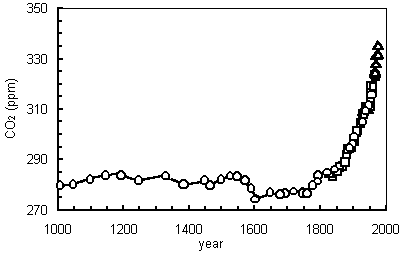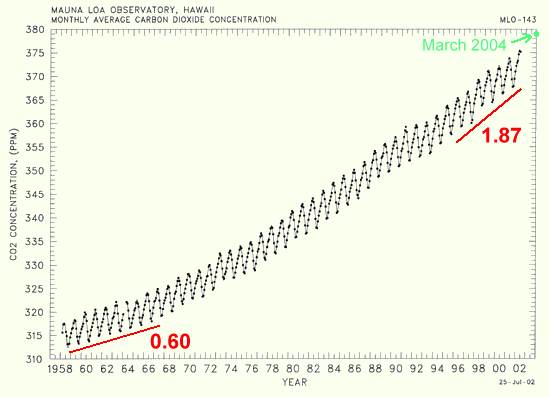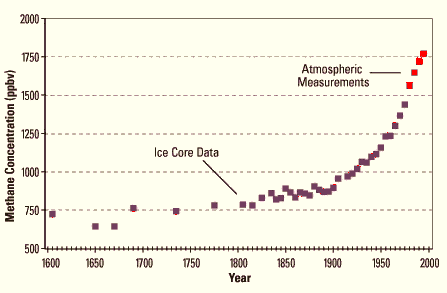The Earth's climate during the past 1000 years
or,
Global warming and cooling during the past 1000 years.
The average temperature of the Earth has varied during the past one
thousand years. Grape growing and wine making were possible in England between 1100
and 1300--a time known as the Medieval Warm Period (MWP). The Vikings settled
Greenland at this time. There were 3000 farmers in Greenland in 1300, but they died
out during a time known as the Little Ice Age (LIA), which ran from 1350 to 1850.
The Thames froze solidly during some winters in Shakespeare's time, an occasion for
"Frost Fairs." The last Frost Fair occurred in 1814, the last time the
Thames froze solidly.[1] The MWP and the LIA
were global phenomena, although not all areas were equally affected. The modern
warming trend started in 1850 and it too is a global phenomenon.
It is possible to estimate the actual temperature increases and
decreases that occurred in the past one thousand years. The MWP was 1°C or 2°C
warmer than the average temperature of the millennium. The LIA was 1°C or 2°C
colder. The current warm era is about 0.75°C warmer and thus not warmer than the
MWP. Grape growing and wine making are still not possible in areas that supported
it during the MWP. These temperature excursions, both positive and negative, are
not very different from excursions occurring during the past 10,000 years.
Atmospheric carbon dioxide

Since carbon dioxide is the most significant greenhouse, it is
natural to examine carbon dioxide levels during the past 1000 years. This graph
shows what happened.

Prior to 1850, carbon dioxide concentration is in the range typical
of a warm, interglacial period. Carbon dioxide concentration is perhaps a little
higher during the MWP and a little lower during the LIA. The correlation is not
very convincing. However, one thing jumps out. Carbon dioxide concentration started
increasing decisively around 1850. By 1900, it is clear that a 400,000 year old
pattern ended.
Data from Mauna Loa Observatory, Hawaii [3]

Here is a month by month record of the carbon dioxide in the
atmosphere going back to 1958 and ending in 2002.

The record looks like saw teeth because the amount of carbon dioxide in the
atmosphere changes over the course of a year. Green plants absorb carbon dioxide
during the summer when they are actively growing. There is more land area in the
Northern Hemisphere and so carbon dioxide concentration decreases during the summer
of the Northern Hemisphere. The carbon dioxide concentration peaks in March, just
before the growing season starts in the Northern Hemisphere.
If you look closely, you will notice that there is a slight flattening starting in
1991 and lasting a year or so. Mount Pinatubo in the Philippines erupted in 1991 and
released a large volume of sulfur dioxide. This reduced ocean surface temperature which
increases the the solubility of carbon dioxide enough to be visible in this curve.
In March of 2004 Mauna Loa Observatory announced that carbon dioxide
concentration had reached 379 parts per million, a fact noted in news sources all
over the world.[4] (This information has
been added in green to the original graph.) The amount of carbon dioxide in the
atmosphere has steadily increased since 1958. The rate of increase was 0.60 parts
per million per year during the 60s, and currently it is 1.87 parts per million per
year. (This information has been added in red to the original graph.) It is clear
that the rate of increase is increasing. It is also clear that a 400,000 year
old pattern has ended. These are alarming facts.
Atmospheric methane

Methane is the second most important greenhouse gas. The greenhouse effect of
methane is 20 times greater than carbon dioxide, but there is less methane in the
atmosphere. The net result is that methane contributes to about 25% of global
warming. Like carbon dioxide, methane concentration started increasing decisively
around 1850. Now methane concentration is at unprecedented levels. This is
additional evidence that the 400,000 year old pattern has ended. This is an
alarming fact.

Cows and termites produce methane. Agriculture, especially rice
growing, produces methane. Anaerobic bacteria living in swamps and garbage dumps
produce methane. Coal mining and oil wells produce methane. The amount of methane
in the atmosphere has increased only slowly since 2000 although methane continues to
enter the atmosphere at the same rate. No one
has put forth a convincing explanation for this.
The fact remains; the amount of methane in the atmosphere is twice as great than at
any time during the last 400,000 years.

[1] http://en.wikipedia.org/wiki/Thames
Learn about the Frost Fairs on the Thames.
[3] http://www.mlo.noaa.gov/
The Mauna Loa Observatory of Hawaii has collected atmospheric data since 1958.
[3] http://cdiac.esd.ornl.gov/trends/co2/sio-mlo.htm
Carbon Dioxide Research Group, Scripps Institution of Oceanography, University
of California, La Jolla, California.
[4] http://www.usatoday.com/weather/news/2004-03-21-co2-buildup_x.htm
One example among many.

|